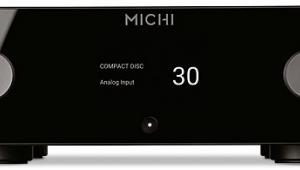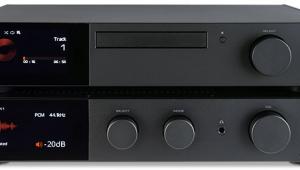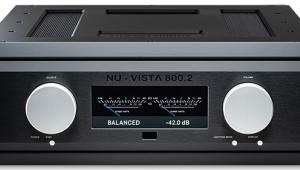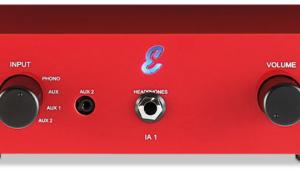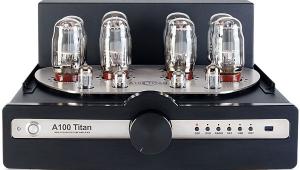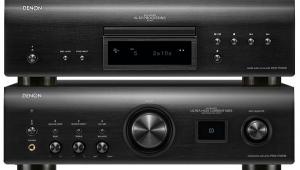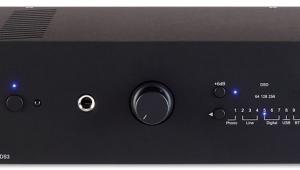Manley Stingray Itube (£2695)
As inescapably all-pervading as swine flu or the taxman, Apple’s iPod is now the most popular source component of all. The generation gap is bookended by Those Who Like Physical Music Carriers and Those Happy To Use Music Files. And, as this is a transitional period, there are those who use both. We are in the middle of a revolution that will render wall-filling libraries of discs about as desirable as typewriters or cathode-ray TVs.
Because of this, canny manufacturers of ‘old school’ hi-fi components who don’t want the new listeners to aspire to nothing more than cheap plastic all-in-one docks have added iPod functionality to their components. Conversely, they want their traditional users to be able to segue into the modern era without sacrificing sound quality. While upscale iPod docks like the marvellous devices from Wadia, Krell, Meridian and others update existing systems, there’s a need for integrateds that are iPod-ready straight out of the box. And that means something more than the cop-out addition of a mini-stereo-jack socket on the front panel.
LIKE A MANTA RAY
EveAnna Manley is a hardcore Apple worshipper, the sort who can’t stop fiddling with her iPhone even in the middle of a meal, so it was a given that she would incorporate iPod egress into one of Manley’s products in a truly comprehensive manner. The existing Stingray, the charming and familiar integrated amp that has been in the Manley Laboratories catalogue since the end of the last century, has evolved steadily, so iPod integration was a natural addition following triode/ultralinear switching, subwoofer out, recording out and a tape loop with a by-pass switch in 2005.
For those who haven’t savoured this modern classic, it’s a funky-looking all-valve integrated that takes its name from its unusual footprint, reminiscent of a manta-ray and therefore in keeping with EveAnna’s penchant for Piscean nomenclature. Rated at 2x20W in triode mode and 2x40W in ultralinear mode [see Lab Report], the selection is made by flicking toggle switches at the back. Valve complement is four EL84s per channel for output, with two 6414s and two 12AT7s triodes as, respectively, driver and input tubes.
As comprehensive as it gets, the Stingray boasts both visible and hidden features, eg, level matching facility, accessible via the multi-functioning infinitely-rotating controls. Balance, tape loop insertion and other minor operations are accessible through a combination of moves, while a remote – which you can run in either IR or RF mode – operates level, ‘dim’ (for a pre-set muting level), input selection and track access from an iPod.
Manley equipped the Stingray with top-quality phono sockets for three line sources plus tape and subwoofer-out, and fitted multi-way binding posts that accept banana plugs as well as over-sized space connectors through slots in the top. Other inputs include a 6.5mm headphone socket and an S-video input on the front, the latter so you can access the sound when watching videos stored on the newer iPods.
Also supplied with the unit is a multimeter – why don’t others do this? – so you can bias the valves through the taps on the amp’s top surface. A comprehensive and insanely-readable owner’s manual talks even frightened novices through the procedure.
In all my years as a reviewer, I cannot recall getting sound out of an unfamiliar product, with so many hidden features, so quickly. Opened the box, removed the packaging, carried the amp to the listening room, wired up the Sophia 2s, slapped in an iPod Classic, plugged in the mains, and that was it – instant joy. I didn’t even have to touch the iPod – I instinctively hit ‘play’ on the remote and it went straight into Pink Floyd’s ‘Another Brick in the Wall’. And to my utter, Apple-despising dismay... it was amazing.
ALL SOUNDING GOOD
OK, so it’s a track that’s been played to death at so many hi-fi shows that it should be banned, but stone me: Nick Mason’s drumming, during the percussion-only gap, tested the mettle of the Sophias – let alone the Manley. In ultralinear mode, it was sharp, the mid-band/treble percussive sounds so crisp that a drummer could probably identify which make of stick Nick uses. But the low end was the surprise, rich and extended and utterly devoid of sag. The sound of bass drum skins responding to a pedal came through loud and clear and, above all, realistically.
Now here’s where I’m gonna cheat a little: when I uploaded nearly 600 tracks to the iPod, I simply sync’d it to my PC, which had everything from WAV files on down. I simply did not pay attention to what encoding was used by which track. They all sounded good. Even the banjo on Alison Krauss’ ‘I Will’ reproduced all of the chiming bluegrass twang you know a banjo must possess. And her vocals floated out sweetly and clearly.
Has the Stingray turned me into an iPod convert? Er, not quite. While its portable supremacy is in no doubt – though I prefer the sound of my wife’s Sansa MP3 player – a feed from the Musical Fidelity’s kW DM25 two-chassis CD player easily exposed the failings of the iPod as a sole source for anyone with hearing that extends in both directions from 200Hz-6kHz. While I couldn’t fault the transparency of the iPod with the aforementioned ‘I Will’, the decay of notes via CD was almost as much of an improvement over the iPod’s as an analogue source’s decay is over digital’s.
What the Musical Fidelity also demonstrated with greater authority was just how good the Stingray iTube can sound with a source worthier of it than a jumped-up hard-drive. Let’s be frank: I know that the primary appeal of the Stingray iTube is its iPod friendliness, but that is to under-use the Manley in the way that not driving an SUV off-road is a denial of its principal capability over a normal saloon.
A QUESTION OF TASTE
Thus forced to use the iPod as much as the CD player, I was still able to extract from the wee Manley the sort of performance I would – blindfolded – have attributed to a system powered by serious separates. Certainly, I would never have guessed that I was listening to a 40-watter. And I was just as impressed by the performance with the power halved in triode mode. Admittedly, the price paid was a slight loosening of the bass in exchange for an airier mid-band and softer treble, but the latter was certainly a matter of taste: in ultralinear form, the treble is so fatigue-free that you have to be some sort of triode-militant to be willing to sacrifice headroom. And Mason’s drumming clearly suffered when the iTube was set to triode, audibly losing impact.
Convinced that ultralinear was the way to go, I fed the Manley a healthy dose of Rare Earth, the lead vocals on ‘I Know I’m Losing You’ possessing a tactile rasp, while the ultra-funk backing – Motown during the Shaft era – burbled underneath. Best of all was whucka-whucka guitar (how is that handled in the Guitar Hero computer game?), which cut through the layers of sound like a machete through a rain forest.
Regardless of the intensity of the music, be it unplugged folk, nasty rock or majestic orchestral, the Stingray continually punched above its weight. As wide a window as is Wilson’s Sophia, the Stingray exhibited no serious, audible failings, though I could reach its SPL limitations with the onset of admittedly inoffensive clipping ... but that was with levels way beyond what I would ever consider to be acceptable. Like John Howes’ modified Quads, the Stingray delights in exceeding its specification.
A TELLING MOMENT
Probably the most telling moment came not with the iPod but with a CD, Jerry Corbitt’s long-overdue Along For The Ride, reviewed by Johnny Black in April. It contains an utterly mental version of ‘Grizzly Bear’, which he first recorded over 40 years ago with the Youngbloods. Presented in 2009 as a jacked-up country-rocker-meets-the-Cramps hoe-down, it contains short, sharp transitions, weird vocal phrasings and enough energy to tax much more powerful amplifiers.
Perhaps sensing in the music an off-the-wall mindset not unlike EveAnna Manley’s, the Stingray rollicked along with the tracks, matching it note for note in speed, intensity and tonal shadings, providing the crystal clarity demanded of most modern country(-ish) music, while maintaining the grungy textures that add so much bite. Trashy drums, cheesy honky-tonk piano, Buck Owens-y Bakersfield C&W guitar, redneck bass plucking: I haven’t tasted this much beer-y bliss since the Blasters turned Streets Of Fire into the ultimate rock’n’roll fantasy flick.
So, while it’s tempting to categorise the Stingray iTube merely as a means of using an iPod in an audiophile-friendly, valve-driven manner, that would sell it short. Instead, it should be regarded first and foremost as a great audiophile amp that just so happens to take iPods directly. All it lacks is a sexy, snap-fitting, cool-looking valve cover…
VERDICT
Even if you don’t own an iPod, the Stingray must feature on any list of integrated amp contenders in the £2k-£3k region. The triode vs. ultralinear option, the magical sound, the superb construction – it’s a delight. But the way it exploits the iPod so perfectly, addressing every function, multiplies its appeal logarithmically. Neater than any external dock, the Stingray is the valve lover’s ideal entrée into the ‘new world’.
Originally published in the September 2009 issue






